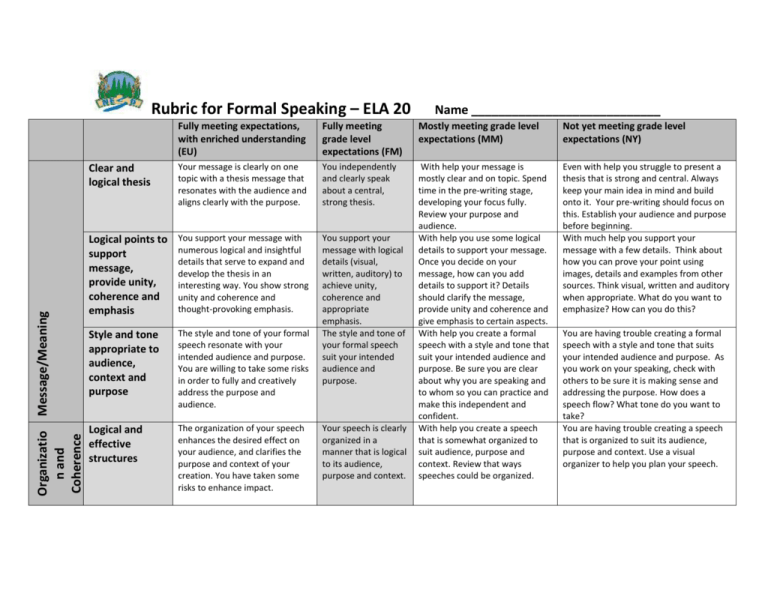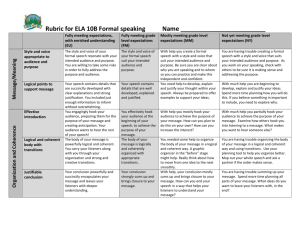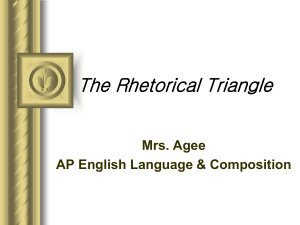Speaking - Formal Rubric
advertisement

Organizatio n and Coherence Message/Meaning Rubric for Formal Speaking – ELA 20 Name ____________________________ Fully meeting expectations, with enriched understanding (EU) Fully meeting grade level expectations (FM) Mostly meeting grade level expectations (MM) Not yet meeting grade level expectations (NY) Clear and logical thesis Your message is clearly on one topic with a thesis message that resonates with the audience and aligns clearly with the purpose. You independently and clearly speak about a central, strong thesis. Logical points to support message, provide unity, coherence and emphasis You support your message with numerous logical and insightful details that serve to expand and develop the thesis in an interesting way. You show strong unity and coherence and thought-provoking emphasis. Even with help you struggle to present a thesis that is strong and central. Always keep your main idea in mind and build onto it. Your pre-writing should focus on this. Establish your audience and purpose before beginning. With much help you support your message with a few details. Think about how you can prove your point using images, details and examples from other sources. Think visual, written and auditory when appropriate. What do you want to emphasize? How can you do this? Style and tone appropriate to audience, context and purpose The style and tone of your formal speech resonate with your intended audience and purpose. You are willing to take some risks in order to fully and creatively address the purpose and audience. You support your message with logical details (visual, written, auditory) to achieve unity, coherence and appropriate emphasis. The style and tone of your formal speech suit your intended audience and purpose. Logical and effective structures The organization of your speech enhances the desired effect on your audience, and clarifies the purpose and context of your creation. You have taken some risks to enhance impact. With help your message is mostly clear and on topic. Spend time in the pre-writing stage, developing your focus fully. Review your purpose and audience. With help you use some logical details to support your message. Once you decide on your message, how can you add details to support it? Details should clarify the message, provide unity and coherence and give emphasis to certain aspects. With help you create a formal speech with a style and tone that suit your intended audience and purpose. Be sure you are clear about why you are speaking and to whom so you can practice and make this independent and confident. With help you create a speech that is somewhat organized to suit audience, purpose and context. Review that ways speeches could be organized. Your speech is clearly organized in a manner that is logical to its audience, purpose and context. You are having trouble creating a formal speech with a style and tone that suits your intended audience and purpose. As you work on your speaking, check with others to be sure it is making sense and addressing the purpose. How does a speech flow? What tone do you want to take? You are having trouble creating a speech that is organized to suit its audience, purpose and context. Use a visual organizer to help you plan your speech. Style and Language Choices Valid and justifiable conclusion Your conclusion powerfully and succinctly encapsulates your message and leaves your listeners with deeper understanding. Your conclusion strongly sums up and brings closure to your message. Smooth transitions Your topic flows eloquently from one part to the next enhancing the overall enjoyment of the speech. You have used engaging and even unique transitions. Skillful use of rhetorical devices You are able to make skillful use of multiple rhetorical devices in order to achieve an engaging effect that suits the audience and purpose. You can explain why you made the decisions you did as it relates to your message. Your speech smoothly flows from one part to the next. You have used appropriate transitions. You are able to make skillful use of rhetorical devices in your speech in order to achieve a desired effect. (ambiguity, contradiction, paradox, irony, incongruity, overstatement, understatement) Voice for characterization and effect Enunciation, inflection, rate, volume, expression, pacing, tone and/or dialect are effectively used to enrich characterization and effect in your message. You consistently use your voice skillfully to communicate your message. Enunciation, inflection, rate, volume, expression, pacing, tone and/or dialect effectively communicate characterization and effect in your message. With help, your conclusion mostly sums up and brings closure to your message. How can you end your speech in a way that helps your listeners to understand your message? With help you attempt smooth movement from one part of your speech to the next. Explore other ways to connect one idea to the next. You are having trouble summing up your message. Spend more time planning all parts of your message. What ideas do you want to leave your listeners with, in the end? With help, you can make use of rhetorical devices in your speech. Continue to look for ways to use rhetorical devices without sacrificing any aspect of your message. How can they be used with the greatest impact? Which works best when? You are having trouble using rhetorical devices in your speech. Be sure that you know what rhetorical devices are. Look for examples in speeches by other people. What impact do they have on you as a listener? How could you use them in your message? With help, enunciation, inflection, rate, volume, expression, pacing, tone and/or dialect mostly communicate characterization and effect in your message. Continue to practice so you become more confident. How do these aspects relate to your audience and message? You are having trouble using enunciation, inflection, rate, volume, expression, pacing, tone and/or dialect effectively to communicate characterization and effect in your message. Try practicing with a mirror or video recorder. Have a checklist so you can work on one thing at a time. With much help you create some flow from one part of your speech to the next. Include your plans for transition in your map. Listen to some speeches to get new ideas. Oral presentation elements to attend to audience and purpose Other cues and conventions attended to Feedback: Your pronunciation, eye contact, facial expressions and poise richly enhance your purpose and the effect of your message on audience. Your pronunciation, eye contact, facial expressions and poise suit your purpose and your audience. With help your pronunciation, eye contact, facial expressions and poise suit your purpose and your audience. With much help and cuing, your pronunciation, eye contact, facial expressions and poise suit your purpose and your audience. Try practicing with a mirror or video recorder. You intuitively use language choices that add richness, power and clarity to your message. Your language choices are suitable to your message. With help you choose language that is suitable to your message. A checklist might help you remember what to look for when proofreading and editing. With much help you choose some language that is suitable to your message. Think about how you can make choices for the best communication. While composing your speech, consult references, ask a partner or seek advice on how to make your language clear.





